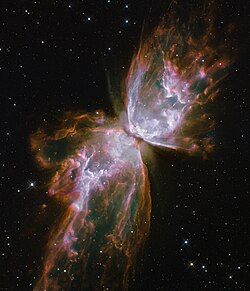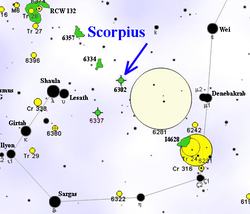NGC 6302
| NGC 6302 | |
|---|---|
 | |
| Constellation | Scorpius |
| Apparent magnitude (V) | 7.1B[1] |
| Apparent diameter | >3′.0[2] |
| Position Epoch: J2000.0 | |
| Right ascension (RA,α) | 17h 13m 44.211s [1] |
| Declination (Dec,δ) | -37° 06′ 15.94″[1] |
| Distance | 3.4 ± 0.5*103 light-year (1.04+-0.16 kilos parsec) [2] |
 | |
| Position of NGC 6302 | |
| Physical property | |
| Radius | > 1.5+-0.2 light-year [3] |
| Absolute magnitude (H) | -3.0B +0.4 −0.3[4] |
| The other name | |
| The other name | |
| ■Project ■ Template | |
NGC 6302 (Caldwell 69) is a bipolar planetary nebula in Scorpius. I am called the butterfly nebula from the form [9]. The structure in a nebula is one of the things which are the most complicated that I was observed in a planetary nebula until now. The surface temperature of the central fixed star is beyond 200,000 K, and the thing that is one of the hottest fixed stars is shown in this Milky Way, and it is suggested by a spectrum that the fixed star which caused the formation was very big (cf. PG1159 star).
The central fixed star was a white dwarf and it was late years and, using wide-field camera 3 of the improved Hubble Space Telescope, was discovered (Szyszka et al. 2009). It is approximately 0.64 sun mass, and the current mass of the fixed star has gas and the very substantial disk made of dusts in the neighborhood. The material flowing out of the fixed star by a disk having high this density will form the bipolar system such as the hourglass (Gurzadyan 1997). This bipolar system shows various interesting structure.
Table of contents
History of the observation
Because these heavenly bodies were included in ニュージェネラルカタログ, I would be known from at least 1,888 years before [10]. The earliest study on NGC 6302 is a thing of Edward Emerson Bernard who described these heavenly bodies in 1907 (Meaburn et al. 2005).
These heavenly bodies were studied for most, and various interesting properties were shown afterwards. The interest of the recent study moved to the property of a large quantity of dust ingredients from mechanism of the excitation of the nebula.
It became one for the first photography after the Hubble Space Telescope started the last service mission in September, 2009 [11].
Property
NGC 6302 has the complicated form that it is similar to in a bipolar system having two robes, but there is evidence to come from one mass loss for the former stage as for these two robes. The dark line of the constriction part of the nebula covers the central fixed star with all wavelengths (Matsuura et al. 2005). Skirt-formed structure at right angles seen by observation in メンゼル 3 was shown to exist (Meaburn et al. 2005). The whole nebula inclines 12.8 degrees.
I extend to the range of 3' .0 from the central fixed star, and the northwest robe of NGC 6302 is estimated when formed by the explosion approximately 1,900 years ago. In this nebula, the wall has a circular part according to the out flow of the Hubble type exactly (here, the speed of the out flow is proportional to the distance from the central source). At the point of depression 1' .71 from the central fixed star, the speed of the flow of this robe is measured with 263km/s1. In the most circumference part of the robe, the speed of the outward arrow exceeds 600km/s. At the west end of the robe, the trace of the collision of the prill of the gas letting an out flow change in quality in this domain is seen (Meaburn et al. 2005).
Central fixed star
Because the central fixed star of this nebula which was one of the things which had highest temperature emitted ultraviolet rays by the high temperature mainly in a known fixed star, and the torus of the dust covered most emission of the ultraviolet rays area particularly again, for a brighter background radiation, I was not detected once. I was not found by the first photography with the Hubble Space Telescope (APoD 2004), but, by wide-field camera 3 which I was improved, and resolution improved, the existence of the dark fixed star became clear (Szyszka et al. 2009). As for the temperature, approximately 200,000 K, mass were shown to be approximately 0.64 sun mass. The original mass of the fixed star was bigger, but was released when a planetary nebula was mainly formed. As for the temperature and the intensity of light of the fixed star, this fixed star has already stopped nuclear fusion, and it is in the white dwarf while by 1% darkens for one year; show that is.
Chemical of the dust
Evidence to have specific chemical composition to be comprised of a crystal of silicate, a crystal of the water, a complex of the crystal in the dark line which is outstanding at the center of the nebula is provided, and the existence of the first hydrocarbon is suggested out of the solar system again, too (Kemper et al. 2002). Because the formation of the hydrocarbon is difficult in the environment without the water, it is still argued about this detection, and the conclusion does not appear (Ferrarotti & Gail 2005).
One of the most interesting characteristics of the dust detected in NGC 6302 is that both material which is rich in oxygen such as silicate and materials which are rich in carbon such as polycyclic aromatic compounds hydrocarbons exist (Kemper et al. 2002). The normal fixed star is comprised only of either material which is rich in oxygen or material which is rich in carbon and has the conversion from the former to the latter by nuclear transmutation and a chemical change in the fixed star atmosphere for last years of the evolution of the fixed star. NGC 6302 belongs to the group of the heavenly bodies where hydrocarbon molecules were formed in the environment that is rich in oxygen (Matsuura et al. 2005).
Footnote
- ^ a b c d e f (SIMBAD 2007)
- ^ a b (Meaburn et al. 2005)
- ^ Radius = distance X sin(angular size / 2) = 3.4+-0.5 kly * sin(>3'.0 / 2) => 1.5+-0.2 ly
- ^ 7.1B apparent magnitude -5 * (log10 (1,040+-160 pc distance) -1) = -3.0B +0.4
−0.3 absolute magnitude - ^ (APoD 1998)
- ^ (APoD 2004)
- ^ O'Meara, Stephen James (2002). The Caldwell Objects. Cambridge University Press. ISBN 0-521-82796-5.
- ^ Feather of the butterfly shining in the space which the Hubble Space Telescope caught, planetary nebula NGC 6302AstroArts
- Butterfly Astro Arts which widens a feather of ^ 3 light-year
- ^ (1) Wolfgang Steinicke, Nebel und Sternhaufen: Geschichte ihrer Entdeckung, Beobachtung und Katalogisierung- von Herschel bis Dreyers, 2009, p.429. (2) Universe Today; (3) Stephen James O'Meara, The Caldwell objects. It is said that James Dunlop discovered it with large number of sources such as Cambridge University Press, 2002, p.274. in 1826.
- ^ News Release Number: STScI-2009-25: Hubble Opens New Eyes on the Universe [1]
Source
- APoD (June 2, 1998), Astronomy Picture of the Day, NASA and Michigan Technological University (MTU
- APoD (May 5, 2004), Astronomy Picture of the Day, NASA and Michigan Technological University (MTU
- Szyszka, C.; Walsh, J. R; Zijlstra, A. A.; Tsamis, Y.G. (2009), "Detection of the Central Star of the Planetary Nebula NGC 6302," it is L32-L3
- Gurzadyan, Grigor A. (1997), The Physics and Dynamics of Planetary Nebulae, Germany: Springer, pp. 3, ISBN 3-540-60965-2
- Meaburn, J.; Lopez, J. A.; Steffen, W.; Graham, M. F.; Holloway, A. J. (2005), "The Hubble-Type Outflows from the High-Excitation, Polypolar Planetary Nebula NGC 6302," it is The Astronomical Journal 130 (5): 2303-2311, arXiv:astro-ph/0507675, Bibcode 2005AJ....130.2303M, doi: 10.1086/49697
- SIMBAD (January 11, 2007), Results for NGC 6302, SIMBAD, Centre de Donnees Astronomiques de Strasbour
- Kemper, F.; Molster, F. J.; Jaeger, C.; Waters, L.B.F.M. (2002), "The mineral composition and spatial distribution of the dust ejecta of NGC 6302," it is 679-690, arXiv:astro-ph/0208110, Bibcode 2002A&A Astronomy and Astrophysics 394...394..679K, doi: 10.1051/0004-6361:2002111
- Ferrarotti, A. S.; Gail, H.-P. (2005), "Mineral formation in stellar winds. V. Formation of calcium carbonate," it is 959-965, Bibcode 2005A&A Astronomy and Astrophysics 430...430..959F, doi: 10.1051/0004-6361:2004185
- Matsuura, M.; Zijlstra, A. A.; Molster, F.J.; Waters, L. B. F. M.; Nomura, H.; Sahai, R.; Hoare, M. G (2005), "The dark lane of the planetary nebula NGC 6302," it is 383-400, Bibcode 2005MNRAS.359..383M, doi: Monthly Notices of the Royal Astronomical Society 359 10.1111/j.1365-2966.2005.08903.
Outside link
This article is taken from the Japanese Wikipedia NGC 6302
This article is distributed by cc-by-sa or GFDL license in accordance with the provisions of Wikipedia.
In addition, Tranpedia is simply not responsible for any show is only by translating the writings of foreign licenses that are compatible with CC-BY-SA license information.
0 개의 댓글:
댓글 쓰기